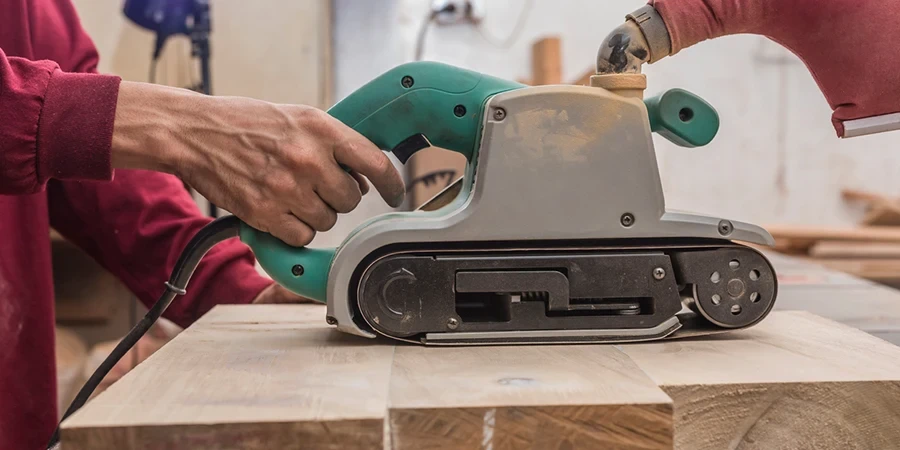2025 年、電動ハンドプレーナー市場は、木工および建設部門の需要の高まりに牽引されて拡大を続けます。この記事では、タイプ、パフォーマンス メトリック、最新のテクノロジーを網羅した包括的な分析を提供します。プロのバイヤーが情報に基づいた決定を下し、最適な在庫選択を確実に行うための貴重な洞察を提供します。
目次:
– 電動ハンドプレーナー市場の概要
– 詳細な市場紹介と分析
– 電動ハンドプレーナーを選択する際の重要な要素
– 電動ハンドプレーナーの最新技術機能
– 製造品質と材料の重要性
– エネルギー効率と環境への配慮
– 適切な電動ハンドプレーナーを選ぶための最終的な考察
電動ハンドプレーナー市場の概要

電動ハンドプレーナーの世界市場は、大幅な成長を遂げています。市場価値は1.2年に2024億米ドルと推定され、1.6年までに2030億米ドルに達し、年平均成長率(CAGR)6.1%で成長すると予測されています。この成長は、商業部門と住宅部門の両方で効率的な木工ツールの需要が高まっていることに支えられています。この市場の成長に貢献している主な地域には、北米、ヨーロッパ、アジア太平洋地域があり、後者は急速な都市化と建設業界の拡大により、最高のCAGRを記録すると予想されています。
市場は、製品タイプ、最終用途、流通チャネル別に区分されています。製品タイプには、コード付きとコードレスの電動ハンドプレーナーがあり、コードレスタイプは携帯性と利便性から人気が高まっています。最終用途セグメントは住宅用と商業用に分かれており、建設や家具製造で広く使用されているため、商業部門が大きなシェアを占めています。流通チャネルは、オフライン(金物店、専門店)とオンラインプラットフォームに分類され、eコマースの採用増加により、オンライン販売が大幅に増加しています。
バッテリー寿命の改善、モーター効率の向上、人間工学に基づいた設計などの技術の進歩は、市場の成長を促進する上で極めて重要です。さらに、住宅所有者の間で DIY プロジェクトが増加する傾向にあるため、電動ハンドプレーナーの需要がさらに高まっています。ただし、初期費用の高さや、より安価な手動代替品の入手可能性などの課題が市場の成長を妨げる可能性があります。
詳細な市場紹介と分析
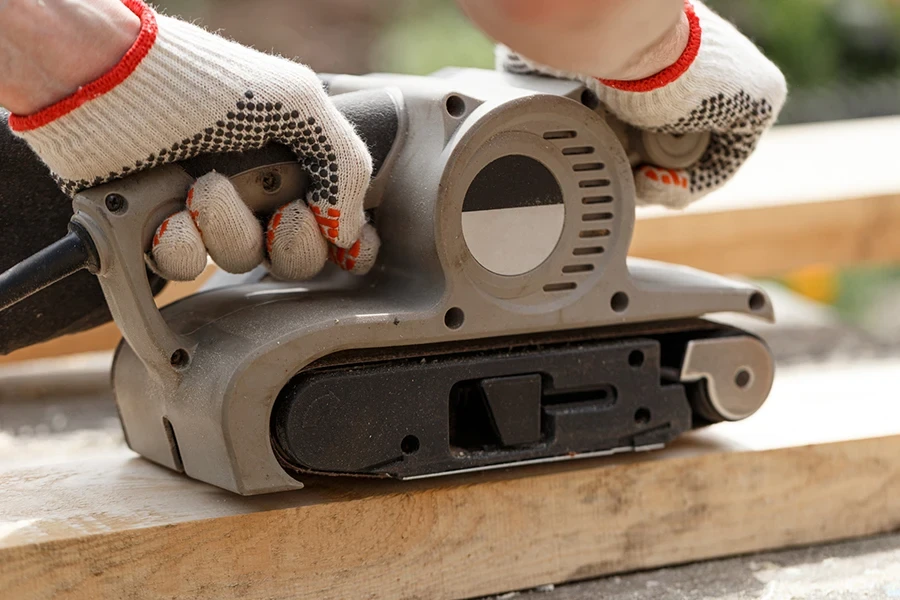
電動ハンドプレーナーは木工作業に欠かせないツールで、木の表面を滑らかで精密に仕上げることができます。これらの機器には、電動モーターで駆動する回転刃が装備されており、材料を効率的に除去できます。電動ハンドプレーナーの主な性能基準には、モーター出力、刃の速度、切削深さ、バッテリー寿命 (コードレス モデルの場合) などがあります。高性能モデルは通常、モーター出力が 5 ~ 7 アンペア、刃の速度が最大 20,000 RPM、切削深さが最大 3/32 インチに調整可能です。
市場シェアの動向を見ると、Bosch、Makita、DeWalt などの大手ブランドが市場を独占しており、合計で世界市場シェアの 60% 以上を占めています。これらのブランドは、革新的なデザイン、堅牢な造り、広範な流通ネットワークで知られています。建設活動の増加と可処分所得の増加は、市場の成長にプラスの影響を与えています。ソーシャル メディアやオンライン チュートリアルによって促進された DIY 住宅改修プロジェクトへの消費者行動の変化も、電動ハンド プレーナーの需要増加に貢献しています。
流通チャネルの好みは進化しており、オンライン プラットフォームへの傾向が高まっています。Amazon などの電子商取引大手や専門オンライン小売業者は、幅広い製品、競争力のある価格、便利な配送オプションを提供しているため、消費者の間で人気があります。市場における最近のイノベーションには、効率を高めるブラシレス モーター、よりクリーンな作業環境を実現する集塵システム、調整可能な速度制御やモバイル アプリとの接続によるリアルタイムの監視と調整などのスマート機能などがあります。
電動ハンドプレーナーの製品ライフサイクルの段階は、安定した需要がある成熟市場を示しています。しかし、継続的な技術の進歩と、騒音や振動のレベルが低減された環境に優しいモデルの導入により、さらなる成長が期待されています。予知保全や使用状況分析のための IoT の統合などのデジタル化のトレンドが勢いを増しており、メーカーに製品の差別化とユーザー エクスペリエンスの向上の機会を提供しています。
顧客の悩みの種は、主にハイエンドモデルの高コスト、コードレスモデルのバッテリー寿命の短さ、定期的なメンテナンスの必要性です。ブランドポジショニング戦略は、これらの懸念に対処するために、耐久性、パフォーマンス、アフターセールスサポートを強調することに重点を置いています。差別化戦略には、延長保証の提供、アクセサリのバンドル、継続的な製品改善のための顧客フィードバックの活用などがあります。
電動ハンドプレーナー業界のニッチ市場には、曲面用に設計されたプレーナーや、さまざまな木材の種類に合わせて刃を交換できるプレーナーなど、特定の木工用途に特化したツールが含まれます。これらのニッチ製品は、ツールの精度と汎用性を求めるプロの木工職人や愛好家のニーズに応えます。
電動ハンドプレーナーを選択する際の重要な要素
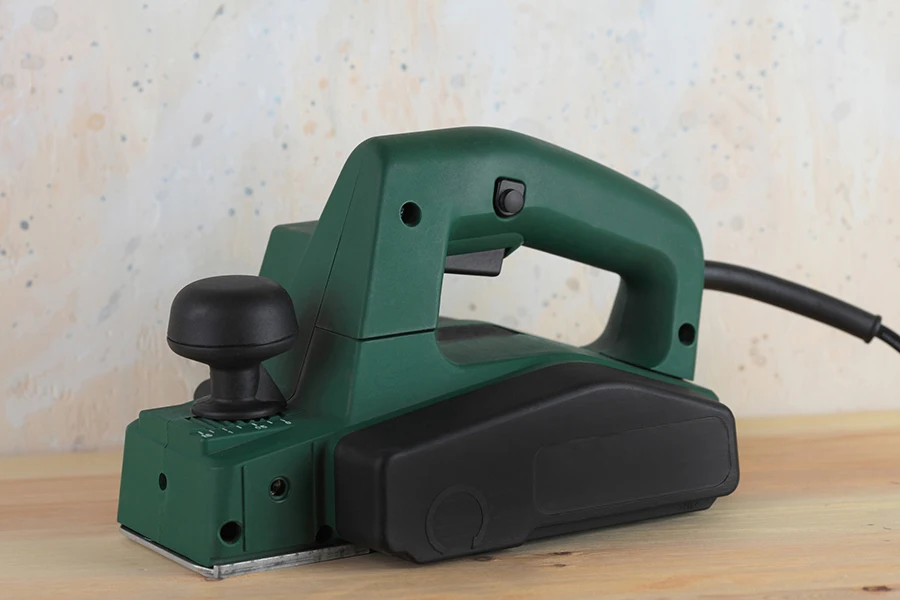
電動ハンドプレーナーを選択する際は、特定の用途に最適なパフォーマンスと適合性を確保するために、いくつかの要素を考慮してください。これには、プレーナーの種類、パフォーマンス メトリック、技術仕様、使いやすさ、安全基準が含まれます。各要素は、ツールの全体的な効率とユーザー エクスペリエンスを決定する上で非常に重要です。
かんなの種類
選択する電動ハンドプレーナーの種類は、その性能とさまざまな作業への適合性に大きく影響します。ポータブルハンドプレーナー、ベンチトッププレーナー、固定式プレーナーがあります。
ポータブル ハンド プレーナーは、移動性に優れているため、現場での作業に最適です。軽量でコンパクトなため、小規模から中規模のプロジェクトに適しています。ベンチトップ プレーナーはより頑丈で、広範囲かつ精密な作業向けに設計されており、作業場の環境でも優れた安定性を発揮します。固定式プレーナーは最もパワフルで、大規模な木工プロジェクトに使用され、通常は作業場に固定され、重い作業も簡単にこなすことができます。
プロジェクトを理解して、最も適切なタイプのプランナーを選択してください。
パフォーマンスメトリクス
パフォーマンス指標は、電動ハンドプレーナーの効率と有効性を判断する上で非常に重要です。主な指標には、モーター出力、切削速度、切削深さなどがあります。
モーターの電力はアンペア (A) で測定され、通常は 5 ~ 15 アンペアの範囲です。アンペア数が高いモーターは、要求の厳しい作業により多くの電力を供給します。切断速度は毎分回転数 (RPM) で測定され、ブレードの回転速度を示します。RPM が高いほど、切断が滑らかになります。切断の深さはミリメートルまたはインチで測定され、XNUMX 回の通過で除去できる材料の量を決定します。深さの設定を調整できるため、精度と制御性が向上します。
これらの指標を評価して、プロジェクトの要求を満たす電動ハンドプレーナーを選択します。
技術仕様
技術仕様では、電動ハンドプレーナーの性能と特徴に関する詳細な情報を提供します。主な仕様には、ブレードの種類、切断幅、集塵システムなどがあります。
ブレードの種類は、高速度鋼 (HSS) ブレードと超硬ブレードの間で異なります。HSS ブレードは柔らかい木材に適しており、より手頃な価格ですが、超硬ブレードは耐久性があり、硬い木材に使用できます。切断幅は、1 回のパスで削ることができる材料の最大幅を示し、幅が広いほど、より効率的に材料を除去できます。
集塵システムは、清潔で安全な作業環境を維持するために不可欠です。多くのプレーナーには、破片やおがくずを捕らえるために真空システムに接続できる集塵ポートが組み込まれています。
これらの仕様を理解して、必要な機能を備えたプランナーを選択してください。
使いやすさ
電動ハンドプレーナーを選ぶ際には、使いやすさが重要です。使いやすさを高める機能には、人間工学に基づいたデザイン、重量、刃の交換のしやすさなどがあります。
人間工学に基づいた設計により、長時間使用しても疲れにくく、快適です。かんなの重さは操作性とコントロール性に影響します。軽いかんなは扱いやすく、重いかんなは精密な作業に優れた安定性を提供します。
ブレードの交換のしやすさも重要です。クイックチェンジブレードシステムを備えたプレーナーを使用すると、ブレードの交換が迅速かつ簡単になり、ダウンタイムが最小限に抑えられ、生産性が向上します。
これらの機能を考慮して、快適で操作しやすいかんなを選択してください。
安全基準
電動ハンドプレーナーを選択する際には、安全基準が重要です。潜在的な危険からユーザーを保護するために、プレーナーが業界の安全基準と認証を満たしていることを確認してください。
ブレードガード、ロックオフスイッチ、過負荷保護などの安全機能を備えたかんなを探してください。ブレードガードはブレードとの偶発的な接触を防ぎ、ロックオフスイッチは偶発的な起動を防ぎ、過負荷保護はモーターの過熱を防ぎます。
国際電気標準会議 (IEC) や国際標準化機構 (ISO) などの公認安全組織からの認定を確認してください。これらは、かんなが厳格な安全性と性能の基準を満たしていることを示します。
安全基準を優先して、安全で規制に準拠した電動ハンドプレーナーを選択してください。
電動ハンドプレーナーの最新技術機能
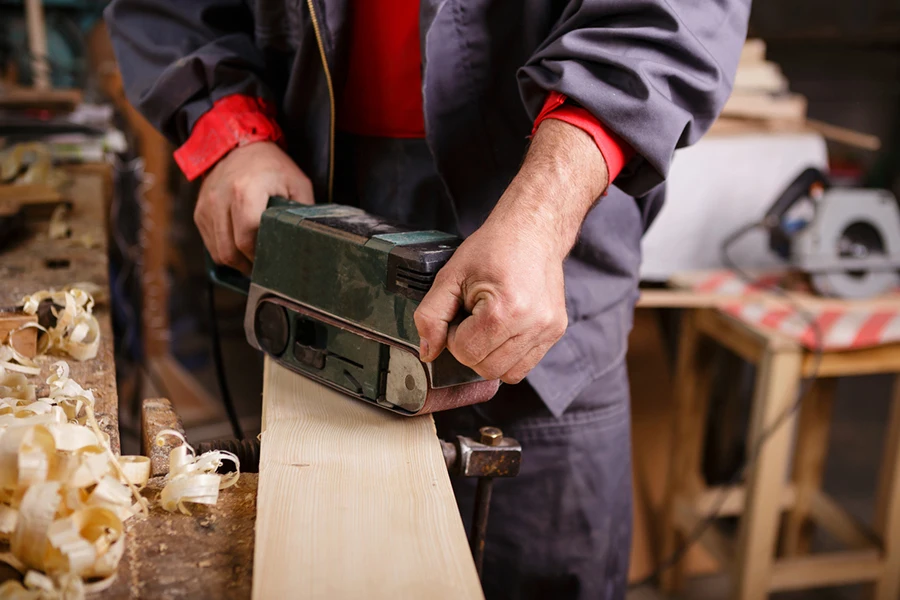
電動ハンドプレーナーは技術面で大きな進歩を遂げ、性能、効率、ユーザーエクスペリエンスが向上しました。最新の機能には、ブラシレス モーター、デジタル深さ制御、統合接続などがあります。
ブラシレスモータ
ブラシレス モーターは大きな進歩です。従来のブラシ付きモーターとは異なり、ブラシは時間の経過とともに摩耗しないため、寿命が長くなり、メンテナンスが減り、効率が向上します。
ブラシレス モーターは、より高いパワーとトルクを提供し、要求の厳しい作業も容易にこなします。効率性も高いため、コードレス モデルではバッテリー寿命が長くなり、コード付きモデルではエネルギー消費が削減されます。
デジタル深度コントロール
デジタル深さ制御により、ユーザーはデジタル インターフェイスを使用して、切削深さを正確に設定および調整できます。この機能により、精度と一貫性が向上し、各パスで必要な量の材料が正確に除去されます。キャビネットや家具の製造など、正確で繰り返し可能なカットを必要とするプロジェクトに特に役立ちます。
統合された接続性
一部のモデルには Bluetooth または Wi-Fi 接続が内蔵されており、ユーザーはかんなをモバイル アプリやその他のスマート デバイスに接続できます。この接続により、かんなの設定、メンテナンス アラート、使用状況データへのアクセスを監視および制御できます。また、ファームウェアの更新も可能になり、かんなを最新の機能と改善で最新の状態に保つことができます。
製造品質と材料の重要性
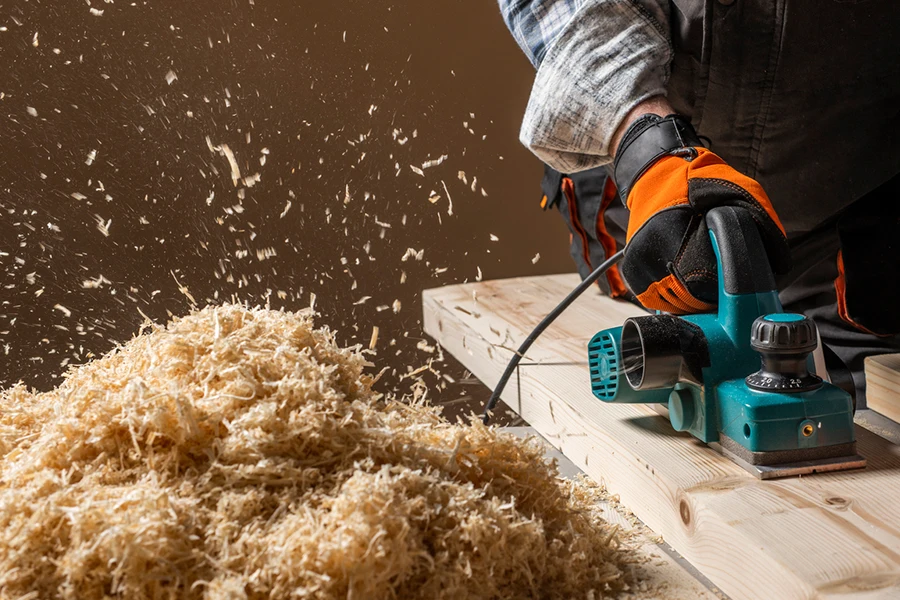
電動ハンドプレーナーの製造品質と使用される材料は、性能、耐久性、寿命にとって非常に重要です。高品質の材料と堅牢な構造により、プレーナーは日常的な使用に耐え、一貫した結果を出すことができます。
材料
構造に使用される材料は、耐久性と性能に影響します。一般的な材料には、アルミニウム、マグネシウム、高級プラスチックなどがあります。アルミニウムは軽量でありながら強度があり、過度の重量をかけずに耐久性を提供します。マグネシウムは優れた強度対重量比と耐腐食性を備えています。高級プラスチックはハンドルやその他の非構造部品に使用され、快適なグリップを提供し、全体の重量を軽減します。
品質を構築
造りの品質とは、全体的な構造と組み立てを指します。しっかりと作られたプレーナーは、許容誤差が小さく、操作がスムーズで、振動が最小限です。精密に機械加工された部品と頑丈な構造のプレーナーを探してください。正確なカットのためにベースは平らで安定している必要があり、ハンドルはしっかりと取り付けられていて快適である必要があります。
耐久性
耐久性は重要です。耐久性のあるプレーナーは、日常的な使用に耐え、長期間にわたって優れた性能を発揮します。カーバイドブレードや高品質のベアリングなどの耐久性のある部品を備えたプレーナーを探してください。カーバイドブレードは摩耗に強く、すぐに鈍くなることなく硬い材料を処理できます。高品質のベアリングはスムーズな操作を保証し、機械の故障のリスクを軽減します。プレーナーの保証と交換部品の入手可能性は、耐久性の指標として考慮してください。
エネルギー効率と環境への配慮
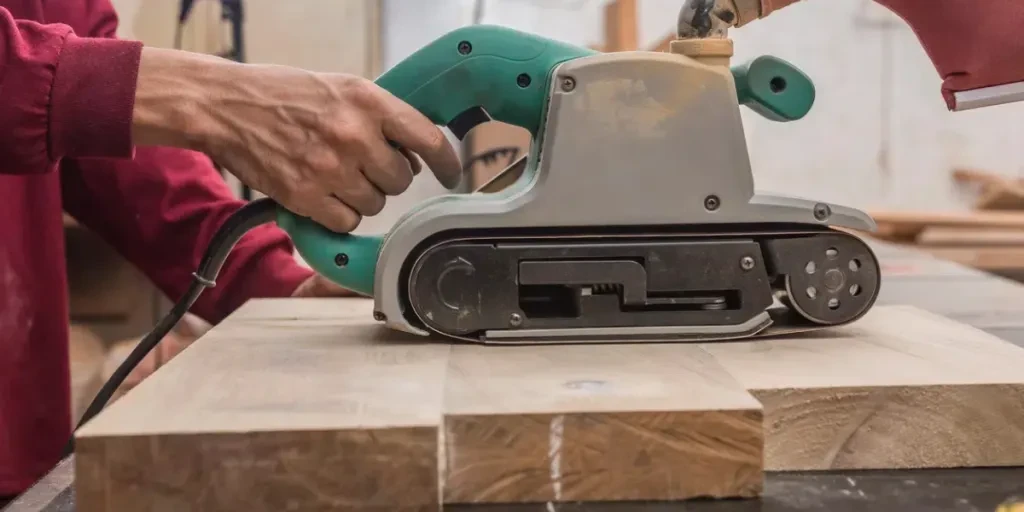
エネルギー効率と環境への配慮はますます重要になっています。技術の進歩により、よりエネルギー効率の高いモデルが生まれ、電力消費と環境への影響が軽減されています。
エネルギー効率
エネルギー効率は、特にコードレス モデルでは重要です。エネルギー効率の高いかんなは消費電力が少なく、バッテリー寿命が長くなり、電気代が削減されます。ブラシレス モーターなどのエネルギー効率の高いモーターを搭載したかんなや、作業内容に応じてモーター速度を調整できる可変速度コントロールを備えたモデルを探して、エネルギー消費をさらに削減してください。
環境影響
環境への影響は、材料、製造プロセス、エネルギー消費によって左右されます。メーカーは、製品の環境負荷を削減するために持続可能な方法を採用しています。リサイクル可能な材料で作られたかんなや、RoHS や WEEE 指令などの環境基準に準拠したモデルを探してください。
今後の動向
今後の傾向は、エネルギー効率の向上と環境への影響の削減に重点が置かれると思われます。バッテリー技術の進歩により、コードレスモデルのバッテリー寿命が延び、充電時間が短縮される可能性があります。持続可能な材料と製造プロセスの採用により、環境への影響は引き続き削減されます。メーカーは、生分解性材料と環境に優しいパッケージングを模索する可能性があります。
適切な電動ハンドプレーナーを選ぶための最終的な考察
まとめると、適切な電動ハンドプレーナーを選択するには、プレーナーの種類、パフォーマンス メトリック、技術仕様、使いやすさ、安全基準など、いくつかの要素を考慮する必要があります。ブラシレス モーター、デジタル深さ制御、統合接続などの技術の進歩により、パフォーマンスとユーザー エクスペリエンスが大幅に向上しました。製造品質、材料、耐久性を優先することで、信頼性の高いパフォーマンスと長期使用が保証されます。エネルギー効率と環境への配慮は、選択プロセスにおいてますます重要になっています。これらの要素を慎重に評価することで、特定のニーズを満たし、持続可能な慣行をサポートする電動ハンドプレーナーを選択できます。
